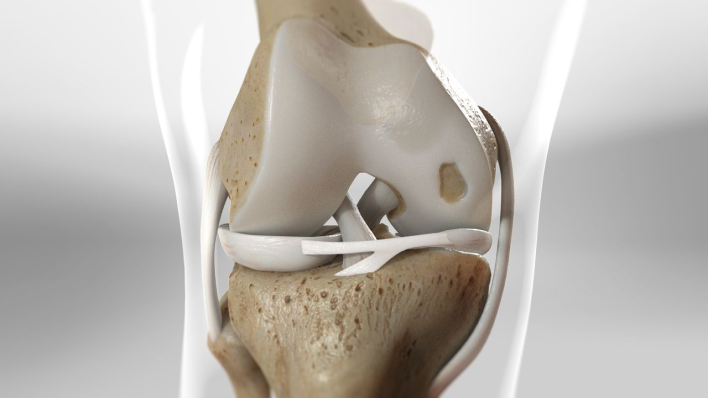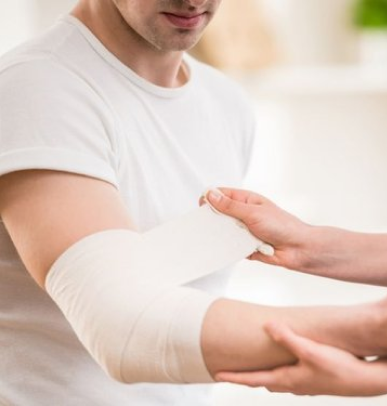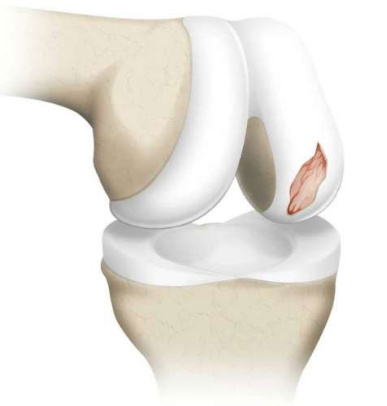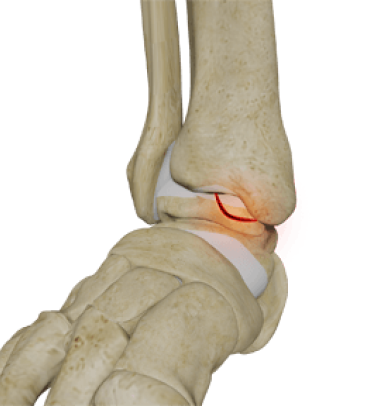Articular Cartilage Injury

Understanding
Articular Cartilage in the Knee
Articular cartilage is a crucial living tissue covering the bones’ ends in the knee joint. This tough yet smooth material provides a frictionless surface, allowing the bones to glide effortlessly during movement.
It plays an essential role in weight-bearing and protects the bones from grinding against each other.
The articular cartilage has a remarkable capacity for self-maintenance, obtaining essential nutrients from the synovial fluid present in the joint. Specialized cells called chondrocytes produce the necessary components to support its structure.
What Is an Articular Cartilage Injury in the Knee?
An injury involving the articular cartilage takes place when this elastic tissue is compromised. These injuries can result from trauma, joint instability, or the gradual impact of wear and tear over time.
Direct impacts during sports like hockey or soccer can damage the cartilage. Injuries can also result from instability events, such as knee or patellar dislocations, often linked to ACL tears.
Articular Cartilage Injury Symptoms
- Pain
- Swelling
- Stiffness
- Locking or Clicking
- Decreased Range of Motion
Anatomy
Common Causes
- Trauma
- Overuse
- Aging
- Underlying Conditions
Types

Partial Thickness Injuries
Damage that affects only the outer layer of the cartilage.

Full Thickness Injuries
Damage that penetrates through the cartilage to the underlying bone.

Chondral Injuries
Specific damage to the articular cartilage.

Osteochondral Injuries
Involves damage to both the cartilage and the underlying bone.
When is the Treatment Recommended?
Treatment is recommended when an articular cartilage injury causes persistent pain, swelling, and limited range of motion that affects daily activities.
If conservative options such as physical therapy or injections do not alleviate symptoms, surgery may be considered.
When conservative treatments, including physical therapy and injections, do not yield relief, surgical options may be explored.
Candidates Eligible
- Experience chronic knee pain due to cartilage damage.
- Have not found relief through non-surgical methods.
- Wish to maintain or improve knee function and mobility.
Diagnosis of Articular Cartilage Injury
Treatment Options for Articular Cartilage Injury
The treatment of knee articular cartilage injury depends on the severity of the damage and the patient’s lifestyle needs. Options include:
Non-Surgical Treatments
- Rest and Ice: The initial treatment typically includes resting the knee and using ice to help alleviate swelling.
- Physical Therapy: Focused exercises can enhance the strength of the surrounding muscles and boost flexibility.
- Medications: Non-steroidal anti-inflammatory drugs (NSAIDs) can alleviate pain and inflammation.
- Injections: Pain-relieving steroid injections can help relieve pain and inflammation for weeks or longer.
- Heat Therapy: Heat therapy, like using a heating pad, can help relax tight muscles and joints while enhancing blood circulation.
Surgical Treatments
- Debridement: This procedure involves removing damaged cartilage and removing loose fragments to enhance joint function and reduce pain.
- Microfracture: In this process, small holes are created in the bottom of the cartilage lesion. The goal is to stimulate the underlying bone to bleed, promoting healing and encouraging the formation of new cartilage.
- Autograft Mosaicplasty: In this procedure, healthy cartilage-bone plugs are harvested from a less-utilized area of the patient’s knee and transplanted to the damaged site. This method is also referred to as autograft osteochondral transplantation (AOT).
- Osteochondral Allograft: This involves implanting healthy donor cartilage-bone plugs into the area of cartilage damage. It effectively replaces unhealthy cartilage, restoring the natural surface, and is particularly useful for larger defects.
- Matrix-Associated Autologous Chondrocyte Implantation (MACI): MACI is a two-step process in which a small sample of healthy cartilage is arthroscopically extracted and cultured to create a new cartilage patch. In the second stage, this collagen patch is applied to the damaged area, facilitating the growth of new cartilage.
- Particulate Juvenile Articular Cartilage: This one-step technique uses small pieces of donor cartilage inserted into the defect. These cartilage “seeds” stimulate the growth of new cartilage, making it particularly effective for repairs in the femur and patella.
- Stem Cell Injections: Stem cells derived from the patient’s bone marrow (from the hip) or adipose tissue (fat) can be utilized alongside any of the procedures above. These injections may enhance healing and support the successful reconstruction of articular cartilage defects.
- Arthroscopic procedures: Articular cartilage surgical knee arthroscopy in Dubai is a minimally invasive procedure that repairs damaged cartilage in the knee. During the procedure, a surgeon uses an arthroscope, a small camera, to examine the knee joint and perform repairs.
Why Choose Tarabichi Joint Care?
Our professionals at Tarabichi Joint Care are dedicated to meeting your special care needs. We use diagnostic tools and provide treatment for articular cartilage injuries using a holistic approach that restores function and helps ease pain.
If you suspect an injury to the articular cartilage, or you’re just experiencing knee pain, do not hesitate to contact us for further evaluation. Let us help you regain your mobility and improve the quality of your life. Contact us today to schedule a consultation with our experienced knee doctor Dubai.
FAQ’S
Articular cartilage repair procedures may include techniques such as microfracture, autologous chondrocyte implantation, or osteochondral grafting. The particular technique employed will depend on both the nature and extent of the injury.
Possible complications may include infection, persistent pain, stiffness, or complications related to anesthesia.
Patients should compile several documents prior to treatment, including a referral from their primary care doctor or orthopedic specialist.
They should also gather previous medical records related to their knee health. Additionally, imaging studies, such as X-rays or MRIs, are needed to assess the condition of the cartilage. Finally, it’s important to compile a list of current medications and any allergies.
